Grönefeld launch the One Hertz Techniek and One Hertz Techniek Nocturne
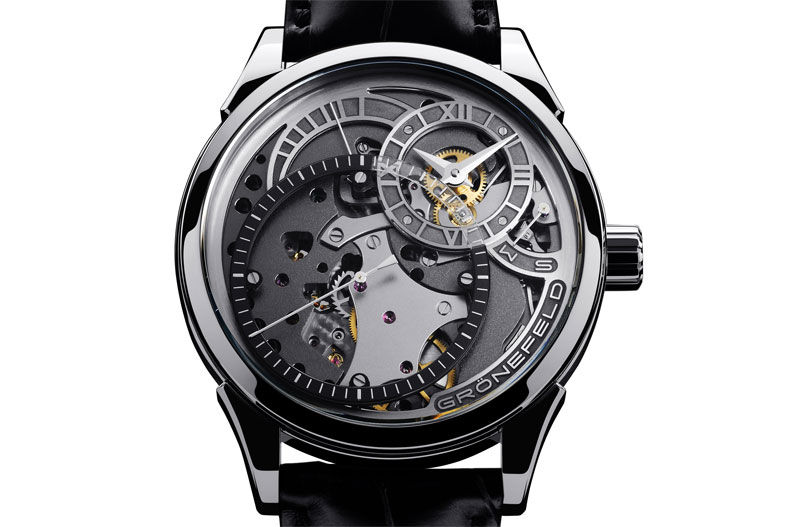
I’m sure that you have heard about the Gönefeld One Hertz by now. If not make sure to check our previous articles about this magnificent dead beat second timepiece made by the Dutch watchmakers Bart and Tim Grönefeld, here, here and here.
Today we introduce the One Hertz with an open-worked dial, revealing all that is beautiful about this watch. Meet the two new sibling of the One Hertz, named One Hertz Techniek and One Hertz Techniek Nocturne. The Grönefeld One Hertz was already loved for it’s beautiful dead beat seconds complication and the marvelous finish of the stainless steel bridges. Now it exposes all its technicalities full-frontal.

The One Hertz Techniek, in polish and brushed titanium, features an open-worked dial that reveals a frosted and black DLC coated main plate. The tracks around the hours/minute sub dial, the power reserve and winding/setting indication are now executed stainless steel. The surface has been laser engraved, so all the markers are shown in bas-relief; the hours 12, 3, 6 and 9 are Roman numerals.
The lower areas are micro-blasted, while the markers are brushed. Just look at the magnificent level of finish. All angles are beveled and polished by hand and the screw-heads are also polished by hand. The new open-worked dial shows a magnificent contrast between the brushed steel, the frosted and DLC coated steel and the yellow of the gears. By the way, one side of the hands is polished, and the other side is micro-blasted, making sure that it’s easy to read the time from any angle you at it.
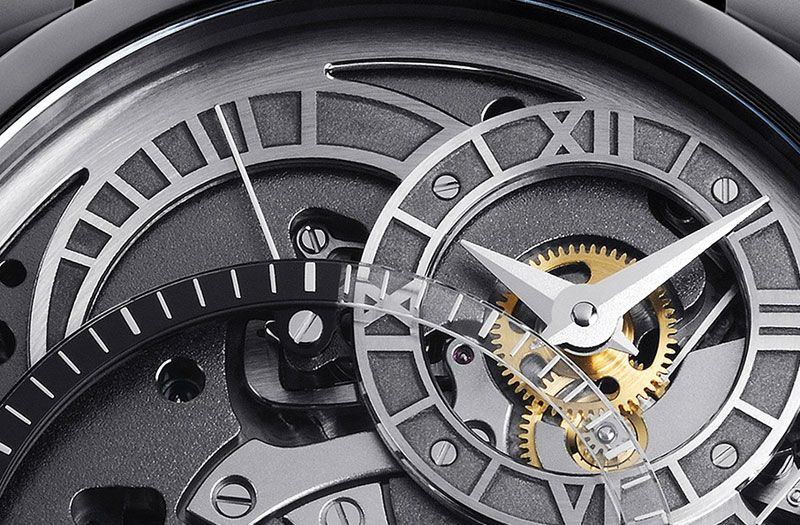
For those who are not that familiar with the Grönefeld One Hertz (that was elected Watch of the Year 2011 by Timezone.com), here’s a brief description:
The One Hertz by Grönefeld is the world’s first independent dead seconds series wristwatch.
At the heart of the hour and minutes subdial at 2 o’clock, we see the hour wheel – logically rotating in 60 minutes – offering a splash of colour and contrast to the largely monochrome movement.
The independent dead seconds – where the second hand advances in full steps of one second instead of the more usually smooth sweeping action of mechanical seconds – features prominently in a large subdial at 7 o’clock. The open dial affords rich views of the large, stainless steel gear train bridge for the dead seconds mechanism, the dead seconds escape wheel and the centre wheel. At the top of seconds dial at 11 o’clock, the lever and spring of the power reserve indicator can also be seen.
The whole ensemble of indications and exposed mechanisms are set off against the dark texture of the hand-frosted mainplate and bridges.
Turning over the One Hertz Techniek completes the mechanical feast for the eyes with the sumptuous display back featuring no fewer than nine finely-crafted stainless steel finger bridges. The One Hertz is the world’s first series movement with all the bridges in stainless steel.
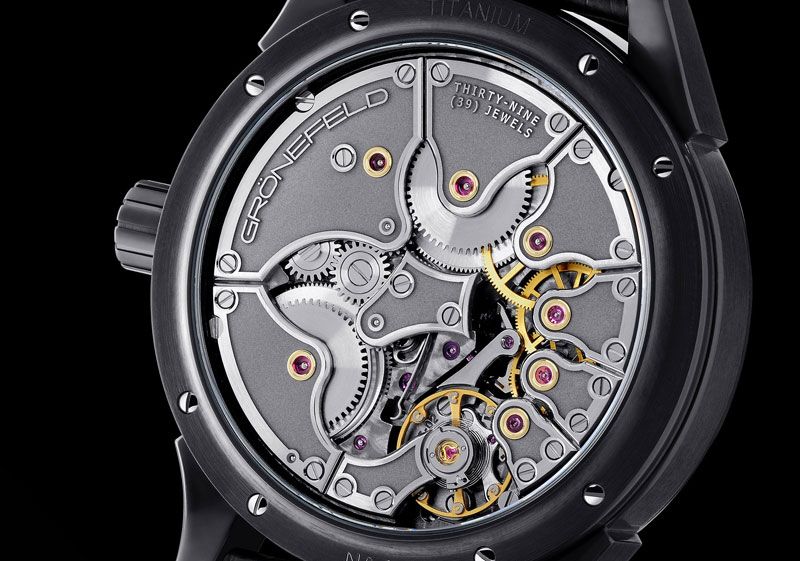
The Grönefeld One Hertz is unique among wristwatches in that its dead seconds are powered by a secondary gear train, independent of the gear train for the hour and minute indications. Here some more information about the dead beat seconds history and technical explanation.
One Hertz
The hertz (symbol: Hz) is the SI unit of frequency defined as the number of cycles per second of a periodic phenomenon. This SI unit is named after Heinrich Hertz. One Hertz simply means “one cycle per second”. Mechanical wristwatch movements often have balance frequencies of 2.5 to 5 hertz, which results in the seconds hand making tiny steps of 5 to 10 steps each second and looking like a smooth movement. The seconds hand of the One Hertz is either stationary (dead) or jumping in a full one-second increment each second.
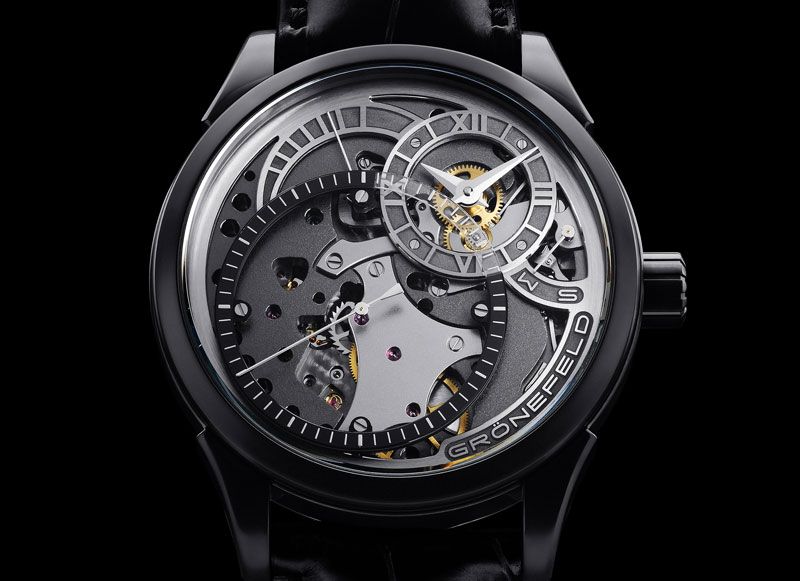
The “One Hertz” independent dead seconds complication
Displaying dead seconds in a wristwatch without a constant force device is no easy task. The friction of the mechanism has to be absolutely minimal so it does not interfere with the escapement, which would have a negative influence on the watch’s chronometric rates.
Bart and Tim Grönefeld used an independent dead seconds mechanism that is driven from its own secondary gear train with its own power supply. The seconds are driven from one mainspring barrel and the hours and minutes from another. Friction is with this system guaranteed to an absolute minimum and the complication has no adverse influence on the escapement and free sprung balance.
The two mainspring barrels are wound simultaneously from the crown, which features an innovative “push to set”, “push to wind function”, with the mode selected indicated at 3 o’clock. A power reserve indicator at the top of the dead seconds dial keeps track of the 72 hours of autonomy.
The One Hertz Techniek (Techniek means technical in Dutch) is available in two version, the One Hertz Techniek – executed in polished and brushed titanium – and its brother the One Hertz Techniek Nocturne that is black DLC coated. The “One Hertz Techniek” is a limited edition of 30 pieces.
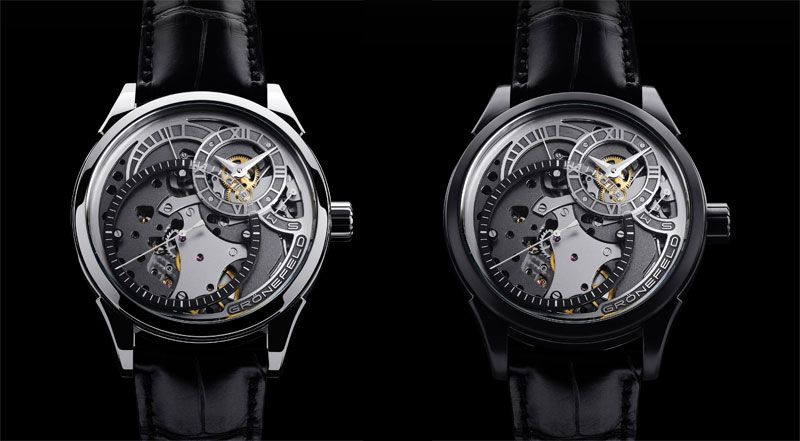
For more information, either check out our previous articles about the Grönefeld One Hertz or check the new Grönefeld website for more technical information and the authorized dealers. Click here to visit the Grönefeld website.
This article is written by Frank Geelen, executive editor for Monochrome Watches.



